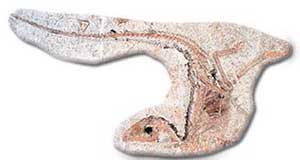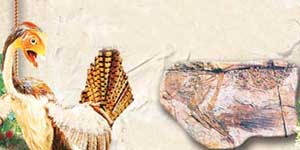Bigotry: The Dark Danger
A Definitive Reply to Evolutionist Propaganda

DOWNLOAD THE BOOK
CHAPTERS OF THE BOOK
- Introduction
- A Series of Blunders Regarding Monkey Intelligence
- The Smuggling Incident National Geographic TV Declined To Cover
- National Geographic TV's Undersea Fairy Tales
- Tall Tales From The National Geographic Channel
- Tales of Transformation from National Geographic Television
- The “Mitochondrial Eve” Deception On The Discovery Channel
- The Dino-Bird Fantasy On The Discovery Channel
- Errors Concerning Human Intelligence From The Discovery Channel
- The Discovery Channel's Spider Dilemma
- Evolutionst Propaganda on The History Channel
- The History Channel's Darwinist and Atheist Propaganda
- New Scientist’s Latest Myth:"Hiccups are a Legacy from Evolution"
- New Scientist’s “ Evolution with Climate” Error
- Paul Davies' Desperate Case for a “Multiverse”
- Evolutionary Tall Tales From The BBC -I-
- Evolutionary Tall Tales From The BBC –II-
- Evolutionary Tall Tales From The BBC –III-
- The BBC's Functionless Tissue Error In Its Documentary The Human Body
- BBC's Evolution of The Human Brain Error
- The Evolutionist Deceptions in the Documentary the Shape of Life
- Evolutionist Deceptions Continue with the Arthropods in the Shape of Life Documentary
- The Evolutionists are Still Struggling with the Same Dilemma: The Origin of Flight
- New Fossil Fish Discoveries Pose a New Dilemma for the Theory of Evolution
- The Latest Version of Baseless Evolutionist Scenarios in Scientific American: Nutrition
- Time Writer M. Lemonick's Mind-Body Error
< <
8 / total: 26
The Dino-Bird Fantasy On The Discovery Channel
A documentary about dinosaurs was broadcast on The Discovery Channel in January 2003. Most of the film was devoted to the way dinosaurs lived. Various dinosaur fossils were presented, and speculations advanced regarding their feeding habits and whether they were carnivorous. In the light of major fossil discoveries, particularly on the continents of Asia and America, the program tried to establish the migratory routes that these giant creatures might have followed. The last 10 minutes of the film consisted of an introduction to the matter of "feathered dinosaurs," so frequently alluded to in evolutionist propaganda. It was maintained that feathers had been found on one fossil, called Caudipteryx, and that this fossil represented an intermediate form in the so-called evolution of birds.
The claims made on The Discovery Channel about the fossils are unfounded. The dino-bird theory, based on two fossils, flies in the face of the scientific facts. A wider consideration of the scientific findings that totally undermine the dino-bird theory can be found at our website www.darwinismrefuted.com. The first of the two fossils given in the film is Sinosauropteryx. When this fossil was first found, in 1996, it was claimed that it had structures similar to feathers. However, later detailed analysis in 1997 revealed that these structures had nothing at all to do with feathers. The evolutionists therefore abandoned their claims that the creature had been feathered. The second species alleged in the documentary to have been feathered is Caudipteryx. Evolutionists are unanimous that Caudipteryx lacked the power of flight. The creature had short arms and long legs, and possessed an anatomy far better suited to running.
The main feature to invalidate the thesis that Caudipteryx might have been the ancestor to the birds is its age. Caudipteryx, which Phil Currie attempts to portray as a transitional species, is some 120 million years old. Archaeopteryx, the oldest known bird, is 30 million years older than that. The 150-million-year old bird Archaeopteryx is solid evidence that Caudipteryx was not an intermediate species. Archaeopteryx lived long before Caudipteryx and was able to fly perfectly, just like modern birds. The dino-bird theory actually constitutes a rather superficial propaganda tool, which is why even some evolutionist scientists reject it. In an article in New Scientist, the famous ornithologist Alan Feduccia sets out the anatomical differences between birds and dinosaurs and states that from the paleontological point of view the theory is a disgrace:
Another ornithologist, Larry Martin, makes this comment in the same article:
Birds are the origin of birds. It is out of the question for dinosaurs or any other land animal to have come by the power of flight as a result of gradual mutations. That is because birds' bodies are specially designed to fly. When one examines the bird wing, feather, lung, and other structures, one encounters particular features peculiar to flight that are not found on any land creatures. The most important feature of this design is its irreducible nature. The wing, lung, and feather need to be present in perfect form in order for flight to be possible. One Turkish evolutionist, Engin Konur, says:
ConclusionIn the light of scientific findings, the theory that birds evolved from dinosaurs, as broadcast by The Discovery Channel, is invalid. Evolutionist sources such as The Discovery Channel shut their ears to the scientific facts and continue to portray this piece of fantastic fiction as if it were a scientific theory. We call on The Discovery Channel to abandon this deception, described by the famous ornithologist Larry Martin as "embarrassing," and to look upon birds and dinosaurs as separate species.
Footnotes1.Pat Shipman, "Birds Do It... Did Dinosaurs?," New Scientist, 1 February 1997,p. 28 2.Pat Shipman, "Birds Do It... Did Dinosaurs?," New Scientist, 1 February 1997, p. 28 3.Engin Korur, "Secret of Eyes and Wings," Bilim ve Teknik (Science and Technology), October 1984, No. 203, p. 25
|
8 / total 26
You can read Harun Yahya's book A Definitive Reply to Evolutionist Propaganda online, share it on social networks such as Facebook and Twitter, download it to your computer, use it in your homework and theses, and publish, copy or reproduce it on your own web sites or blogs without paying any copyright fee, so long as you acknowledge this site as the reference.



